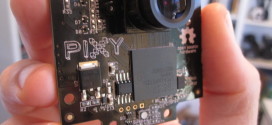 The HiTechnic Angle Sensor was released a few weeks ago and I’ve been eagerly awaiting a production version of it. The wait is over now and of course the first thing that came to my mind was “I wonder what it looks like on the inside.”
The HiTechnic Angle Sensor was released a few weeks ago and I’ve been eagerly awaiting a production version of it. The wait is over now and of course the first thing that came to my mind was “I wonder what it looks like on the inside.”
Gus from HiTechnic did mention that it uses a magnetic sensor to detect the movement of the axle on the MindBoards forums but that’s not really saying much. So I wasted no time taking a sharp blade to the casing and opening this thing up. I would not recommend doing this with your own. It took quite a bit of fiddling around to put it back together. Not to mention a new white sensor casing.
 |
 |
| Side view, the axle sort of hangs in the frame, it is held in place by the front piece (not shown here). | The back of the PCB. There is a small processor on it and a few components. |
 |
 |
| You can see the magnetic field sensor. | The axle with the small magnet on the back. It has a Lego axle hole on the front. |
Here’s a small video of the axle spinning around and a small test program I made to check the functionality of my driver. The really cool thing about this sensor is its ability to retain its position even when it’s power cycled. That means that if you make a robot arm and hook these up on all its rotational points, you can safely shutdown the NXT and have the robot know exactly what its position is when it comes back online. Pretty freaking handy, if you ask me. You can set the zero point at any position you like.
If only I had had a bunch of these when making my giant robot arm! A driver for this sensor should be in the next release of the 3rd Party ROBOTC Driver Suite.
 Bot Bench I'd Rather Be Building Robots
Bot Bench I'd Rather Be Building Robots




Can this be used as a tachometer? For speed measurement?
Sure, you can measure RPM (revolutions per minute) with it. If you know how fast something spins, you could conceivably calculate speed.
– Xander
Is this really that useful? I’m not questioning the usefulness of the sensor itself, but why stick the rod out the front of the sensor head?
I’d have designed it to be something about 2m thick, maybe 3m +/- long, and however tall, and had a pin hole, then the axle hole [through the whole thing like the RCX one], and then another pin hole to attach it to a beam. I would think this way it would be more useful
—beam— 0 + 0 —beam— axle hole in middle [+] would be for rotation/degree measure, and two holes to pin the thing to a beam for ease of use.
I am sure they considered several designs. Don’t forget that it has to fit inside a LEGO sensor casing shell. Only the black cover part can be changed. That would make it quite hard to realise your design, both electronically and mechanically.